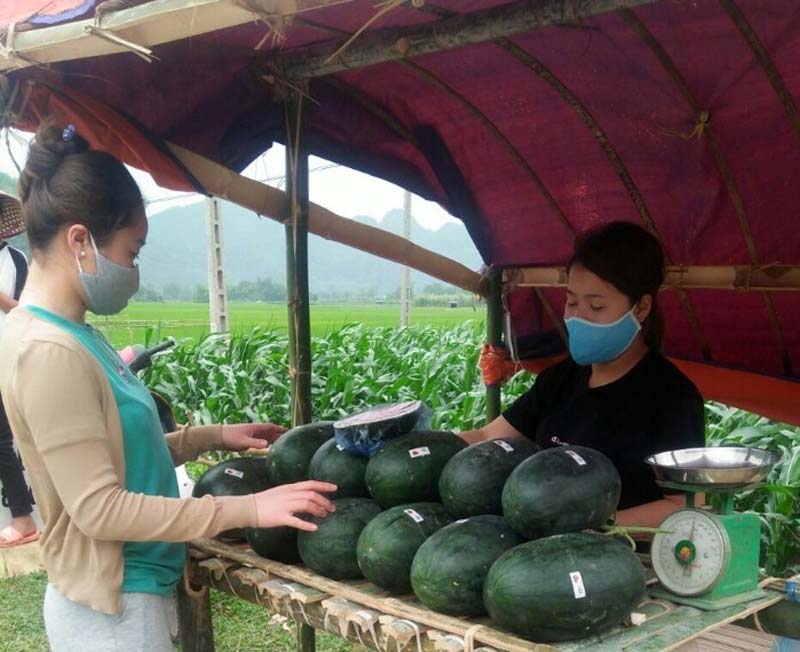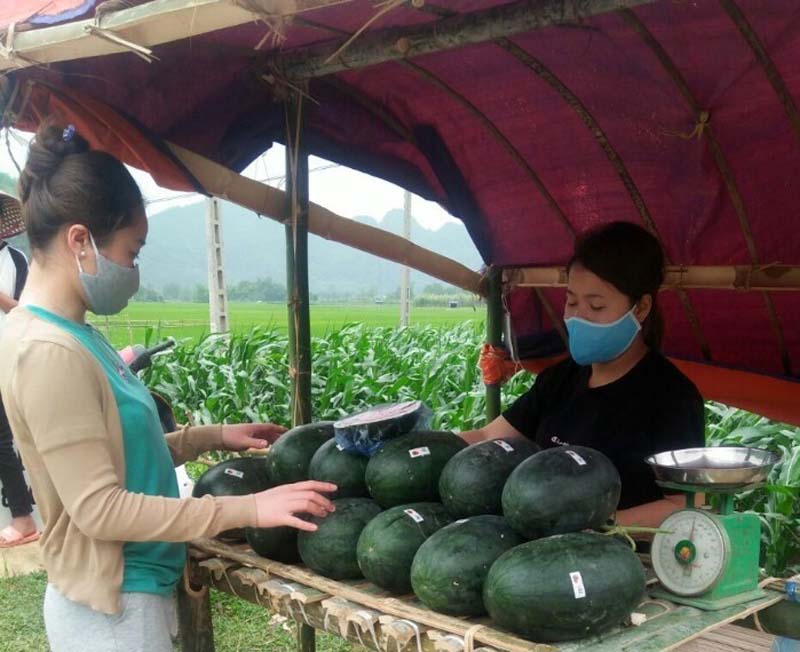
(HBO) - Watermelons have fallen in love with Mai Ha (Mai Chau) for a long time. Mai Ha watermelons are big, red and sweet so they been bought by traders everywhere. The local authorities and the people here want to build a brand for Mai Ha watermelons and gradually produce them according to VietGAP standards to bring Mai Ha watermelons beyond the locality.
 Mai Ha watermelons (Mai Chau) have been stamped with
traceability stamps, contributing to improving the product value.
Mai Ha watermelons (Mai Chau) have been stamped with
traceability stamps, contributing to improving the product value.
Since the beginning of April, although the people in Mai Ha
commune and the people all over the country have seriously taken the measures
to prevent Covid-19 epidemics, there is still a glimpse of the industrious
farmer who harvests watermelons in the fields of Chieng Ha, Kha, and Lau
villages of Mai Ha. From farmers, traders to retail customers, they always keep
the right distance and wear face masks. This year's watermelon season, the
farmers in Mai Ha have gained a good season. Watermelons are in a good season
with the best prices, and traders from Hanoi, Son La, Ninh Binh ... come to the
garden to collect them.
There have been 46 hectares growing watermelon in Mai Chau
district (doubling compared to that of 2019), of which, there are 42.16
hectares of watermelons in Mai Ha commune, the rest is grown in Van Mai
commune. The productivity is from 28 - 30 tons / ha. Currently, the wholesale
price of the watermelons in the garden range from 7,000 to 8,000 VND / kg. The
retail price is from 10,000 to 13,000 VND / kg.
Mr. Kham Thai Sau, the Chairman of the People's Committee of
Mai Ha says: Watermelons have been identified as the key crop by the Party
Committee, authorities and people of Mai Ha. The commune has been trying to
maintain the area of 40-42 ha for growing watermelons. This year, the greatest
joy of the watermelon growers and the whole commune is that Mai Ha watermelons
have been stamped traceability. Currently, there are more than 10,000
traceability stamps issued to the watermelon growers. We are aiming to
establish cooperatives to develop production according to the link chain. In
2021, we are trying to grow watermelons according to VietGAP standards to
enhance the product value, affirming the brand of Mai Ha watermelons in the
market.
It is required that melon growers must strictly comply with the
planning and care process according to VietGAP standards so that Mai Ha
watermelons will be available in supermarkets and the chains of clean
agricultural product stores across the country. In particular, it is necessary
to build the links between businesses and farmers in a chain and sustainable
production links.
According to data from the Hoa Binh Provincial Party Committee, the industrial production index for the first six months of 2025 is estimated to have increased by 20% compared to the same period last year. This marks the highest year-on-year growth rate for this period since 2020.
In the first six months of 2025, Hoa Binh province’s export turnover was estimated at 1.145 billion USD, marking an 18.11% increase compared to the same period in 2024. Import turnover was estimated at $ 804 million, a 17.15% increase, which helped the province maintain a positive trade balance.
The lives of the ethnic minority farmers in Tan Lac district have gradually improved thanks to the new directions in agricultural production. This is a testament to the collective strength fostered through the professional associations and groups implemented by various levels of the district’s Farmers’ Union.
With the motto the "product quality comes first,” after nearly one year of establishment and operation, Muong village’s Clean Food Agricultural and Commercial Cooperative, located in Cau Hamlet, Hung Son Commune (Kim Boi district), has launched reputable, high-quality agricultural products to the market that are well-received by consumers. The products such as Muong village’s pork sausage, salt-cured chicken, and salt-cured pork hocks have gradually carved out a place in the market and they are on the path to obtaining the OCOP certification.
In the past, the phrase "bumper harvest, rock-bottom prices" was a familiar refrain for Vietnamese farmers engaged in fragmented, small-scale agriculture. But today, a new spirit is emerging across rural areas of Hoa Binh province - one of collaboration, organisation, and collective economic models that provide a stable foundation for production.
Maintaining growing area codes and packing facility codes in accordance with regulations is a mandatory requirement for agricultural products to be eligible for export. Recently, the Department of Agriculture and Environment of Hoa Binh province has intensified technical supervision of designated farming areas and packing facilities to safeguard the "green passport" that enables its products to access international markets.



 Mai Ha watermelons (Mai Chau) have been stamped with
traceability stamps, contributing to improving the product value.
Mai Ha watermelons (Mai Chau) have been stamped with
traceability stamps, contributing to improving the product value.